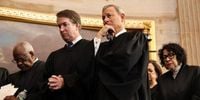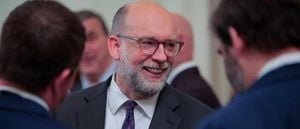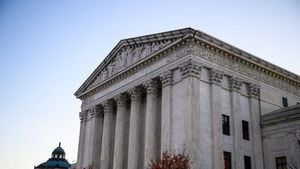On Wednesday, November 5, 2025, the U.S. Supreme Court found itself at the center of a constitutional storm, grappling with whether President Donald Trump’s use of emergency powers to impose sweeping tariffs had crossed the line into congressional territory. The case, Learning Resources, Inc. v. Trump, drew national attention as justices from across the ideological spectrum questioned the legality of Trump’s reliance on the 1977 International Emergency Economic Powers Act (IEEPA) to justify a record-breaking tariff regime—a move that has upended global trade and stirred fierce debate about the limits of presidential authority.
Trump’s tariffs, a hallmark of his “America First” agenda, have jolted the U.S. economy and international relations alike. According to reporting from Bloomberg, these levies have spiked the average U.S. tariff rate to 16.3%, the highest level since the Great Depression. In just six months, the tariffs have generated $151 billion in federal revenue—a 300% increase compared to the previous year. Yet, as the Supreme Court heard arguments, the real question was whether such unilateral action by the president is constitutionally sound, or if it constitutes an overreach that undermines Congress’s explicit powers over taxation and trade.
The crux of the dispute centers on Trump’s invocation of IEEPA, a statute originally crafted to give presidents flexibility in responding to international crises—think terrorism, narcotics, or cyberattacks. Historically, IEEPA has been used to freeze assets or block transactions with hostile actors. But as The Atlantic points out, the law’s text does not mention tariffs or taxing power, raising eyebrows among legal scholars and justices alike. Solicitor General D. John Sauer, defending the administration, argued that IEEPA’s authority to “regulate importation” should naturally include the power to impose tariffs during emergencies. “Without nimble tariff powers, we’d be defenseless,” Sauer asserted, emphasizing the importance of flexibility in times of crisis.
But the justices weren’t so easily convinced. Chief Justice John Roberts pressed Sauer on the Constitution’s clear assignment of taxation powers to Congress, noting IEEPA’s silence on tariffs. Justice Sonia Sotomayor echoed this concern, stating bluntly, “The Constitution assigns taxing to Congress, not the president.” Justice Amy Coney Barrett took the practical angle, probing the potential for “refund chaos” if the tariffs were struck down—an outcome that could cost up to $750 billion, according to estimates cited by the Wall Street Journal. Even conservative justices, often sympathetic to executive authority, appeared wary of endorsing what some described as a “slippery slope” of endless emergencies.
Justice Brett Kavanaugh, however, seemed to lean toward upholding the president’s powers. He referenced the recent use of tariffs as leverage in foreign policy, saying, “The tariff on India, right? That’s designed to help settle the Russia-Ukraine war, as I understand it.” Yet, as The Atlantic observed, not all of Trump’s tariffs fit neatly into a national security narrative. The administration imposed a 50% tariff on India, a 10% tariff on Canada—reportedly in retaliation for a TV ad that embarrassed Trump—and a 40% tariff on Brazil, despite the U.S. running a trade surplus with that country. Such actions, critics argue, make it difficult to justify the tariffs as genuine responses to emergencies.
Challengers to the tariffs, led by former Solicitor General Neal Katyal, argued that Trump’s actions amount to a “vast economic” power grab that demands explicit congressional authorization under the so-called major questions doctrine. “No president has tariffed allies like this,” Katyal declared, warning that allowing such power would set a dangerous precedent—enabling future presidents to tax or sanction foreign goods over mere policy disagreements. This view has found support in lower courts, which have consistently ruled against the administration. As the Court of Appeals for the Federal Circuit stated in August, “imposing tariffs is a core congressional prerogative,” and while IEEPA allows the president to take significant actions in emergencies, it does not explicitly grant the authority to impose tariffs or taxes.
The ripple effects of Trump’s tariff strategy have been felt far beyond the courtroom. Economists estimate that the tariffs have cost U.S. households about $1,200 annually, with small businesses and importers bearing much of the brunt. According to the New York Times, more than 40 amicus briefs have been filed by companies, Democratic-led states, and even some conservative legal groups, all urging the Court to rein in presidential power. These groups argue that the tariffs have failed to deliver promised benefits—such as shielding consumers from inflation or reducing the federal deficit—while fueling uncertainty and raising prices on everyday goods.
Trump himself has framed the case in existential terms, calling it a “life-or-death” moment for American economic security. While he skipped the oral arguments to avoid “distractions,” his top lieutenants, Treasury Secretary Scott Bessent and Trade Representative Jamieson Greer, attended in his stead. Bessent, speaking to Fox News after the hearing, remained optimistic: “Strong case made.” Yet, as markets reacted with little more than a shrug—the S&P 500 ticked up slightly—the real fallout will depend on the Court’s decision, expected in spring 2026.
If the justices uphold Trump’s use of IEEPA to impose tariffs, analysts predict that the president could double down on his aggressive trade tactics, potentially igniting new trade wars and further straining relations with key allies. On the other hand, if the Court strikes down the tariffs, rates could be halved and the government might be forced to issue massive refunds—an outcome that would reverberate from retail shelves to international capitals. In the short term, fallback provisions could cap duties at 15%, sparing some recently renegotiated trade deals.
The case has also reignited debate over the separation of powers—a foundational principle of the American system. The Constitution vests the power to “lay and collect Taxes, Duties, Imposts and Excises” squarely in Congress, and Article I, Section 7, specifies that all bills for raising revenue must originate in the House of Representatives. As The Atlantic highlights, the Founders designed these checks to prevent any one branch, or individual, from wielding unchecked authority over the nation’s purse strings. The major questions doctrine, which the Court invoked in the 2023 decision striking down President Biden’s student loan forgiveness plan, holds that Congress must speak clearly when granting the executive branch powers of vast economic and political significance.
Yet, in the current climate, those lines have blurred. Trump’s administration has justified tariffs on the grounds of combating fentanyl trafficking—citing seizures of over 5,000 pounds from Mexico and just 64 pounds from Canada in early 2025—but critics argue that such emergencies are either exaggerated or misapplied. The United States has run trade deficits for nearly half a century, and as The Atlantic wryly notes, “something that has been going on since before most Americans were born is hardly an emergency.”
With a decision looming, the stakes could hardly be higher. The justices must weigh not only the letter of the law but also the enduring balance of power between Congress and the president. Will the Court reaffirm Congress’s central role in taxation and trade, or will it open the door to a new era of executive-driven economic policy? As the country waits for an answer, one thing is certain: the outcome will shape America’s economic landscape—and its constitutional order—for years to come.
Amid all the legal wrangling and political theater, the Supreme Court’s forthcoming decision will serve as a defining test of whether one leader’s claimed “emergency” can truly trump the careful checks and balances at the heart of American democracy.




